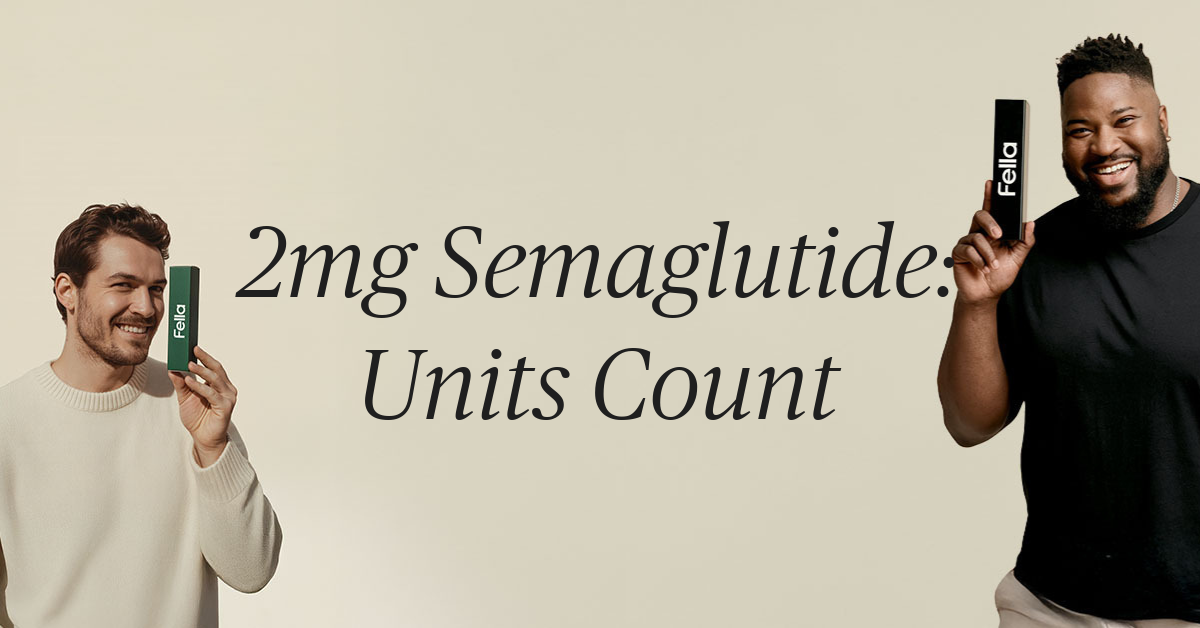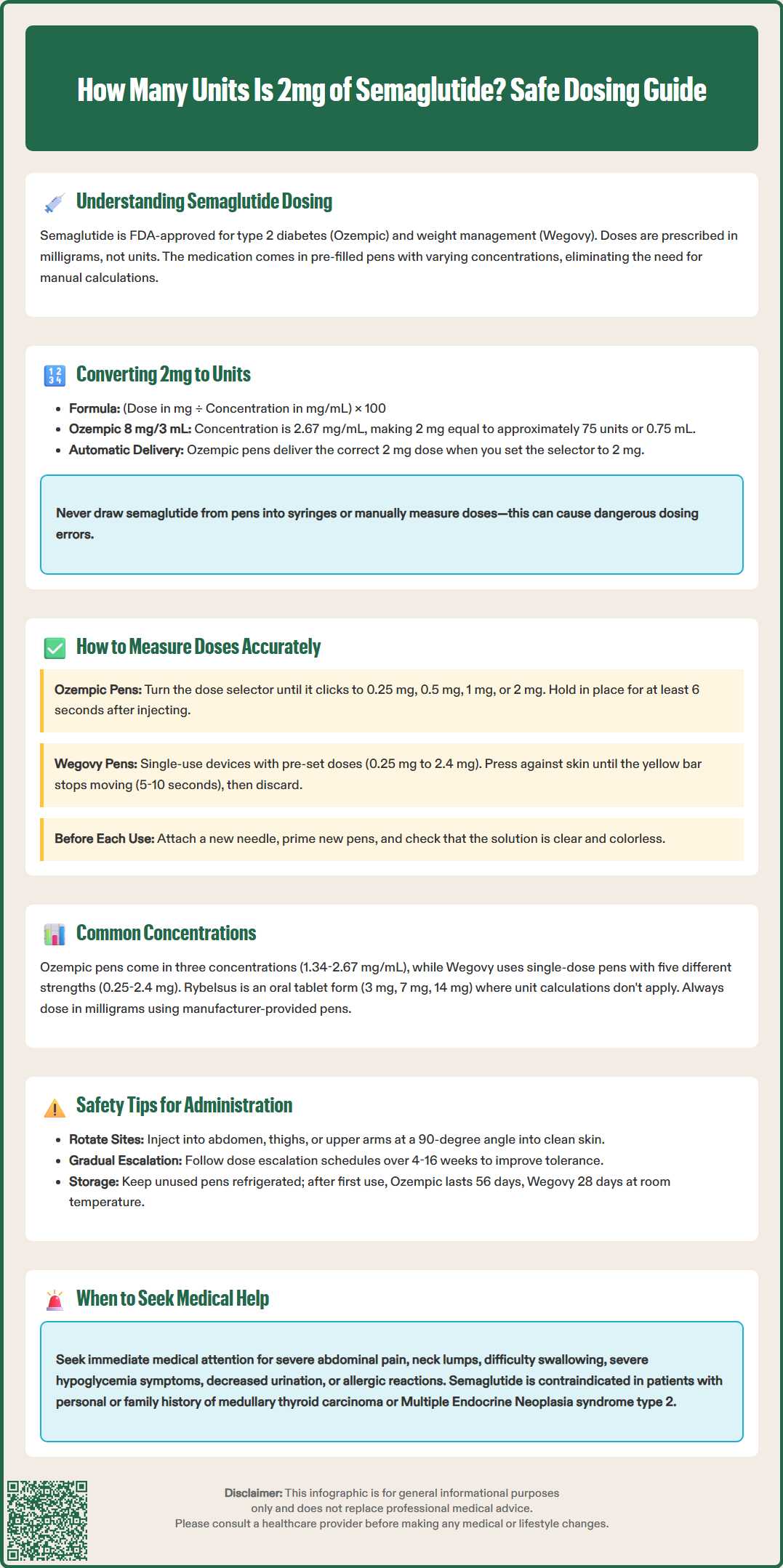LOSE WEIGHT WITH MEDICAL SUPPORT — BUILT FOR MEN
- Your personalised programme is built around medical care, not willpower.
- No generic diets. No guesswork.
- Just science-backed results and expert support.
Find out if you’re eligible

Understanding how many units correspond to 2mg of semaglutide is essential for safe medication administration, though semaglutide is prescribed in milligrams rather than units in clinical practice. For a 2mg dose using the Ozempic 8mg/3mL pen (concentration 2.67mg/mL), this equals approximately 75 units when calculated using standard U-100 insulin syringe measurements. However, patients should never manually measure semaglutide doses with syringes. The FDA-approved pre-filled pen devices are specifically engineered to deliver accurate milligram doses through built-in dose selectors or fixed single-dose mechanisms, eliminating the need for unit-based calculations and significantly reducing the risk of potentially dangerous dosing errors.
Quick Answer: 2mg of semaglutide equals approximately 75 units when using the Ozempic 8mg/3mL pen, but patients should always use the pre-filled pen's dose selector rather than manually measuring doses.
Semaglutide is a glucagon-like peptide-1 (GLP-1) receptor agonist approved by the FDA for type 2 diabetes management (under the brand name Ozempic) and chronic weight management (Wegovy). Understanding the relationship between milligrams (mg) and injection units is essential for safe and effective administration.
The term "units" in injectable medications refers to volume measurements marked on U-100 insulin syringes, where 100 units equals 1 milliliter (mL). However, semaglutide pens display doses in milligrams (mg), not units. The number of units corresponding to a specific milligram dose depends entirely on the concentration of the medication—that is, how many milligrams are dissolved in each milliliter of solution.
For semaglutide, the concentration varies by product formulation:
Ozempic pens come in multiple strengths: 2 mg/1.5 mL, 4 mg/3 mL, and 8 mg/3 mL
Wegovy pens are single-dose devices with different concentrations: 0.25 mg, 0.5 mg, and 1.0 mg in 0.5 mL; 1.7 mg and 2.4 mg in 0.75 mL
It is critical to recognize that semaglutide is not dosed in "units" in clinical practice. Prescriptions specify the dose in milligrams, and the pre-filled pen devices are designed to deliver the exact milligram dose. Ozempic pens have a dose selector that clicks to the prescribed dose, while Wegovy pens deliver a fixed, single dose. Attempting to manually calculate or draw up doses using insulin syringes is not recommended and increases the risk of dosing errors, which can lead to inadequate glycemic control or adverse effects such as severe nausea, vomiting, and hypoglycemia.

To convert 2 mg of semaglutide to injection units, you must know the specific concentration of your semaglutide product. The calculation follows this formula: Units = (Dose in mg ÷ Concentration in mg/mL) × 100, where multiplying by 100 converts milliliters to units (since standard U-100 insulin syringes measure 100 units per mL).
For Ozempic 8 mg/3 mL pen (used for the 2 mg dose): The concentration is approximately 2.67 mg/mL. To deliver 2 mg:
Volume needed = 2 mg ÷ 2.67 mg/mL = approximately 0.75 mL
In units: 0.75 mL × 100 = approximately 75 units
Ozempic pens are designed to deliver the 2 mg dose via the pen's dose selector when using the 8 mg/3 mL pen. The pen automatically delivers the correct volume when the dose selector is set to 2 mg.
Important safety note: These calculations are provided for educational understanding only. Patients should never attempt to draw up semaglutide from pens into syringes or manually measure doses. The pre-filled pen devices are specifically engineered to deliver accurate doses and include safety features to prevent dosing errors. Always use the manufacturer's pen devices as directed by your healthcare provider and according to the FDA-approved Instructions for Use.
Accurate measurement of semaglutide doses is achieved through proper use of the FDA-approved pre-filled pen injectors, not through manual measurement with syringes. Each semaglutide product has specific administration requirements.
Using Ozempic Pens: Ozempic pens allow dose selection of 0.25 mg, 0.5 mg, 1 mg, or 2 mg per injection (depending on pen strength):
Remove the pen cap and attach a new pen needle
Perform a flow check (prime the pen) before first use of each new pen
Turn the dose selector until it clicks to your prescribed dose (the dose window will display the number in mg)
Inject subcutaneously into the abdomen, thigh, or upper arm
Hold the pen in place for at least 6 seconds after pressing the dose button to ensure full dose delivery
Using Wegovy Pens: Wegovy pens are single-dose, single-use devices with integrated needles. Each pen contains one specific dose (0.25 mg, 0.5 mg, 1 mg, 1.7 mg, or 2.4 mg):
Remove the pen cap (no needle attachment needed)
Place the pen against your injection site and press the dose button
Keep the pen pressed against the skin until the yellow bar stops moving (typically 5-10 seconds)
Discard the pen after a single use
Key accuracy principles:
For Ozempic: Always use a new needle for each injection to ensure proper flow
Store unused pens according to package instructions (refrigerated)
Never share pens between patients, even with a new needle
Check the medication window to ensure the solution is clear and colorless before injecting
Follow the manufacturer's Instructions for Use exactly
Understanding the different semaglutide formulations and their concentrations helps clarify why unit calculations vary and reinforces the importance of using products as intended by the manufacturer.
Ozempic (for type 2 diabetes):
Theoretical unit equivalents: 0.25 mg ≈ 19 units; 0.5 mg ≈ 37 units
4 mg/3 mL pen (1.34 mg/mL):
Theoretical unit equivalent: 1 mg ≈ 75 units
8 mg/3 mL pen (2.67 mg/mL):
Wegovy (for chronic weight management): Each Wegovy pen is a single-dose, single-use device:
0.25 mg/0.5 mL (0.5 mg/mL) ≈ 25 units
0.5 mg/0.5 mL (1 mg/mL) ≈ 50 units
1 mg/0.5 mL (2 mg/mL) ≈ 50 units
1.7 mg/0.75 mL (2.27 mg/mL) ≈ 75 units
2.4 mg/0.75 mL (3.2 mg/mL) ≈ 75 units
Rybelsus (oral semaglutide): Rybelsus is an oral tablet formulation available in 3 mg, 7 mg, and 14 mg strengths. Unit calculations do not apply to oral medications.
Clinical context: These unit calculations are provided solely for educational purposes. In clinical practice, semaglutide dosing is always prescribed and administered in milligrams using the manufacturer's delivery devices. The American Diabetes Association Standards of Care emphasize the importance of proper patient education on device use to optimize treatment outcomes and minimize errors.
Safe administration of semaglutide requires attention to proper injection technique, dose escalation protocols, and recognition of adverse effects that may require medical attention.
Injection technique and site selection:
Rotate injection sites with each dose to minimize injection-site reactions
Acceptable sites include the abdomen (at least 2 inches from the navel), front of the thighs, and outer upper arms
Clean the injection site with an alcohol swab and allow it to dry before injecting
Inject at a 90-degree angle for most patients; those with less subcutaneous fat may use a 45-degree angle
Never inject into areas that are tender, bruised, red, or hard
Dose escalation and timing:
Ozempic is typically initiated at 0.25 mg weekly for 4 weeks, then increased to 0.5 mg weekly, with further increases to 1 mg and potentially 2 mg weekly if needed for glycemic control
Wegovy follows a 16-week escalation schedule: 0.25 mg → 0.5 mg → 1 mg → 1.7 mg → 2.4 mg, typically increasing every 4 weeks
Administer once weekly on the same day each week; if a dose is missed, take it as soon as possible within 5 days
If more than 5 days have passed, skip the missed dose and resume the regular schedule
Contraindications and warnings:
Semaglutide is contraindicated in patients with a personal or family history of medullary thyroid carcinoma (MTC) or Multiple Endocrine Neoplasia syndrome type 2 (MEN 2)
Patients should be monitored for potential complications including pancreatitis, gallbladder disease, hypoglycemia (when used with insulin or sulfonylureas), and diabetic retinopathy complications
Recognizing and managing adverse effects: Common side effects include nausea, vomiting, diarrhea, abdominal pain, and constipation. These are usually mild to moderate and decrease over time. However, seek immediate medical attention if you experience:
Severe, persistent abdominal pain (possible pancreatitis)
Signs of thyroid tumors: lump in the neck, hoarseness, difficulty swallowing, or shortness of breath
Symptoms of severe hypoglycemia (when used with insulin or sulfonylureas): confusion, dizziness, severe sweating, or loss of consciousness
Signs of kidney problems: decreased urination, swelling in legs or feet, unusual fatigue
Severe allergic reactions: rash, itching, severe dizziness, difficulty breathing
Storage and disposal:
Store unused pens in the refrigerator (36°F to 46°F); do not freeze
After first use, Ozempic pens may be stored at room temperature (59°F to 86°F) or refrigerated for up to 56 days
Unused Wegovy pens may be kept at room temperature (≤86°F) for up to 28 days; discard immediately after single use
Dispose of used needles in an FDA-cleared sharps container; never throw loose needles in household trash
Keep pens with the cap on when not in use to protect from light
No, you should never use insulin syringes to manually measure semaglutide doses. The FDA-approved pre-filled pen devices are specifically designed to deliver accurate milligram doses and include safety features that prevent dosing errors, which could lead to serious adverse effects.
Ozempic pens have adjustable dose selectors allowing multiple injections per pen (0.25mg, 0.5mg, 1mg, or 2mg doses), while Wegovy pens are single-dose, single-use devices with integrated needles that deliver one fixed dose (0.25mg, 0.5mg, 1mg, 1.7mg, or 2.4mg) and must be discarded after use.
If you miss a dose, take it as soon as possible within 5 days of the missed dose. If more than 5 days have passed, skip the missed dose and resume your regular weekly schedule on your next scheduled day.
All medical content on this blog is created using reputable, evidence-based sources and is regularly reviewed for accuracy and relevance. While we strive to keep our content current with the latest research and clinical guidelines, it is intended for general informational purposes only.
This content is not a substitute for professional medical advice, diagnosis, or treatment. Always consult a licensed healthcare provider with any medical questions or concerns. Use of this information is at your own risk, and we are not liable for any outcomes resulting from its use.